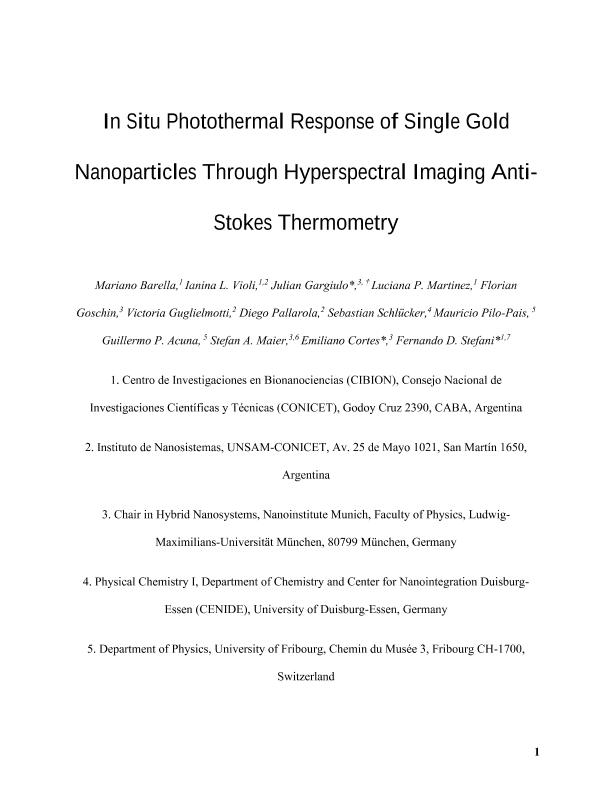Mostrar el registro sencillo del ítem
dc.contributor.author
Barella, Mariano

dc.contributor.author
Violi, Ianina Lucila

dc.contributor.author
Gargiulo, Julian

dc.contributor.author
Martínez, Luciana Paula

dc.contributor.author
Goschin, Florian
dc.contributor.author
Guglielmotti, Victoria

dc.contributor.author
Pallarola, Diego Andres

dc.contributor.author
Schlücker, Sebastian
dc.contributor.author
Pilo Pais, Mauricio
dc.contributor.author
Acuna, Guillermo P.

dc.contributor.author
Maier, Stefan A.
dc.contributor.author
Cortés, Emiliano

dc.contributor.author
Stefani, Fernando Daniel

dc.date.available
2022-09-28T18:26:43Z
dc.date.issued
2020-09-17
dc.identifier.citation
Barella, Mariano; Violi, Ianina Lucila; Gargiulo, Julian; Martínez, Luciana Paula; Goschin, Florian; et al.; In situ photothermal response of single gold nanoparticles through hyperspectral imaging anti-stokes thermometry; American Chemical Society; ACS Nano; 15; 2; 17-9-2020; 2458-2467
dc.identifier.issn
1936-0851
dc.identifier.uri
http://hdl.handle.net/11336/170794
dc.description.abstract
Several fields of applications require a reliable characterization of the photothermal response and heat dissipation of nanoscopic systems, which remains a challenging task for both modeling and experimental measurements. Here, we present an implementation of anti-Stokes thermometry that enables the in situ photothermal characterization of individual nanoparticles (NPs) from a single hyperspectral photoluminescence confocal image. The method is label-free, potentially applicable to any NP with detectable anti-Stokes emission, and does not require any prior information about the NP itself or the surrounding media. With it, we first studied the photothermal response of spherical gold NPs of different sizes on glass substrates, immersed in water, and found that heat dissipation is mainly dominated by the water for NPs larger than 50 nm. Then, the role of the substrate was studied by comparing the photothermal response of 80 nm gold NPs on glass with sapphire and graphene, two materials with high thermal conductivity. For a given irradiance level, the NPs reach temperatures 18% lower on sapphire and 24% higher on graphene than on bare glass. The fact that the presence of a highly conductive material such as graphene leads to a poorer thermal dissipation demonstrates that interfacial thermal resistances play a very significant role in nanoscopic systems and emphasize the need for in situ experimental thermometry techniques. The developed method will allow addressing several open questions about the role of temperature in plasmon-assisted applications, especially ones where NPs of arbitrary shapes are present in complex matrixes and environments.
dc.format
application/pdf
dc.language.iso
eng
dc.publisher
American Chemical Society

dc.rights
info:eu-repo/semantics/openAccess
dc.rights.uri
https://creativecommons.org/licenses/by-nc-sa/2.5/ar/
dc.subject
ANTI-STOKES NANOTHERMOMETRY
dc.subject
GRAPHENE
dc.subject
METAL PHOTOLUMINESCENCE
dc.subject
METALLIC NANOPARTICLES
dc.subject
OPTICAL PRINTING
dc.subject
PLASMONICS
dc.subject
THERMOPLASMONICS
dc.subject.classification
Nano-materiales

dc.subject.classification
Nanotecnología

dc.subject.classification
INGENIERÍAS Y TECNOLOGÍAS

dc.title
In situ photothermal response of single gold nanoparticles through hyperspectral imaging anti-stokes thermometry
dc.type
info:eu-repo/semantics/article
dc.type
info:ar-repo/semantics/artículo
dc.type
info:eu-repo/semantics/publishedVersion
dc.date.updated
2022-09-26T17:49:48Z
dc.identifier.eissn
1936-086X
dc.journal.volume
15
dc.journal.number
2
dc.journal.pagination
2458-2467
dc.journal.pais
Estados Unidos

dc.journal.ciudad
Washington
dc.description.fil
Fil: Barella, Mariano. Consejo Nacional de Investigaciones Científicas y Técnicas. Oficina de Coordinación Administrativa Parque Centenario. Centro de Investigaciones en Bionanociencias "Elizabeth Jares Erijman"; Argentina
dc.description.fil
Fil: Violi, Ianina Lucila. Universidad Nacional de San Martin. Instituto de Nanosistemas; Argentina. Consejo Nacional de Investigaciones Científicas y Técnicas. Oficina de Coordinación Administrativa Parque Centenario. Centro de Investigaciones en Bionanociencias "Elizabeth Jares Erijman"; Argentina
dc.description.fil
Fil: Gargiulo, Julian. Ludwig Maximilians Universitat; Alemania. Consejo Nacional de Investigaciones Científicas y Técnicas; Argentina
dc.description.fil
Fil: Martínez, Luciana Paula. Consejo Nacional de Investigaciones Científicas y Técnicas. Oficina de Coordinación Administrativa Parque Centenario. Centro de Investigaciones en Bionanociencias "Elizabeth Jares Erijman"; Argentina
dc.description.fil
Fil: Goschin, Florian. Ludwig Maximilians Universitat; Alemania
dc.description.fil
Fil: Guglielmotti, Victoria. Universidad Nacional de San Martin. Instituto de Nanosistemas; Argentina. Consejo Nacional de Investigaciones Científicas y Técnicas; Argentina
dc.description.fil
Fil: Pallarola, Diego Andres. Universidad Nacional de San Martin. Instituto de Nanosistemas; Argentina. Consejo Nacional de Investigaciones Científicas y Técnicas; Argentina
dc.description.fil
Fil: Schlücker, Sebastian. Universitat Essen; Alemania
dc.description.fil
Fil: Pilo Pais, Mauricio. University Of Fribourg; Suiza
dc.description.fil
Fil: Acuna, Guillermo P.. University Of Fribourg; Suiza
dc.description.fil
Fil: Maier, Stefan A.. Ludwig Maximilians Universitat; Alemania. Imperial College London; Reino Unido
dc.description.fil
Fil: Cortés, Emiliano. Ludwig Maximilians Universitat; Alemania
dc.description.fil
Fil: Stefani, Fernando Daniel. Universidad de Buenos Aires. Facultad de Ciencias Exactas y Naturales. Departamento de Física; Argentina. Consejo Nacional de Investigaciones Científicas y Técnicas. Oficina de Coordinación Administrativa Parque Centenario. Centro de Investigaciones en Bionanociencias "Elizabeth Jares Erijman"; Argentina
dc.journal.title
ACS Nano

dc.relation.alternativeid
info:eu-repo/semantics/altIdentifier/url/https://pubs.acs.org/doi/10.1021/acsnano.0c06185
dc.relation.alternativeid
info:eu-repo/semantics/altIdentifier/doi/http://dx.doi.org/10.1021/acsnano.0c06185
dc.relation.alternativeid
info:eu-repo/semantics/altIdentifier/url/https://arxiv.org/ftp/arxiv/papers/2108/2108.10954.pdf
Archivos asociados
